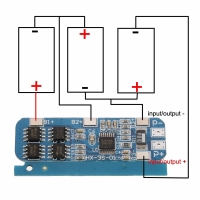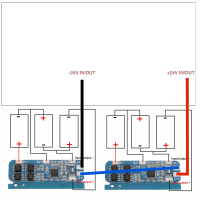Hello,
I have a screwdriver and a 24V NiCd drill and driver, very little used and in great condition, but the packages with cells were lost.
I can buy replacements and still have NiCd, but I happen to have 20 3.6V Li-Ion cells, unused. I decided to use them.
I will use 6 cells,
But I have a problem with charging. The original charging station is for NiCd, so it will not be useful, it will work, but if I forget to turn off, you know what will happen. So option number two is to mount the charger on the packet and simply charge it with a pulse charger. And here is the problem...
I have never met Li-Ion 6S charging control modules, i.e. for 6 cells.
They are on 1/2/3/4 and that's it.
Without etch design etc., wouldn't it be possible to use such a module:
https://abc-rc.pl/modul-ladowania-3s-12v
And connect one to 3 cells, and another three to another, connect the outputs in series to receive 24 V and connect it as a power supply?
I am a layman, I have no magical knowledge and I wonder if two packages connected in series can be safely used as one 24 V?
Will charging with a 24V impulse charger be ok? Is there more tension then and what?


I have a screwdriver and a 24V NiCd drill and driver, very little used and in great condition, but the packages with cells were lost.
I can buy replacements and still have NiCd, but I happen to have 20 3.6V Li-Ion cells, unused. I decided to use them.
I will use 6 cells,
But I have a problem with charging. The original charging station is for NiCd, so it will not be useful, it will work, but if I forget to turn off, you know what will happen. So option number two is to mount the charger on the packet and simply charge it with a pulse charger. And here is the problem...
I have never met Li-Ion 6S charging control modules, i.e. for 6 cells.
They are on 1/2/3/4 and that's it.
Without etch design etc., wouldn't it be possible to use such a module:
https://abc-rc.pl/modul-ladowania-3s-12v
And connect one to 3 cells, and another three to another, connect the outputs in series to receive 24 V and connect it as a power supply?
I am a layman, I have no magical knowledge and I wonder if two packages connected in series can be safely used as one 24 V?
Will charging with a 24V impulse charger be ok? Is there more tension then and what?




